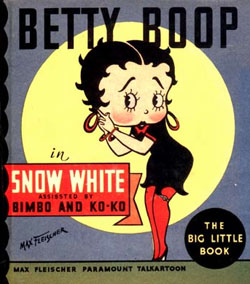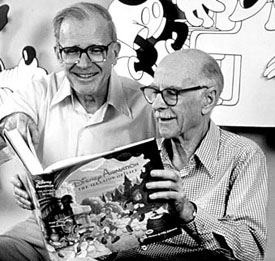 The Animated Calloway. A rotoscoped version of scat singer Cab Calloway appeared in the Betty Boop cartoon shorts Minnie the Moocher (1932), Snow White (1933) and The Old Man of the Mountain (1933). The Fleischers were able to get musical talent because of their connection to Paramount and its Famous Music division. “When Cab saw (himself in cartoon form), he screamed in laughter and stretched himself out of the floor!” Lou Flesicher told animation historian Ray Pointer. “Some months later I met Cab Calloway and asked, ‘Did our cartoon help or hurt your show when it went on the road?’ He said, ‘Are you kidding? We had your cartoon shown the week before we arrived at every theater and on its account none of the house could accommodate the crowds that came. Are you kidding?’” Of course jazz legend Louis Armstrong was transformed into a cannibal for the Betty Boop short I’ll Be Glad When You Are Dead, You Rascal You (1932).
The Animated Calloway. A rotoscoped version of scat singer Cab Calloway appeared in the Betty Boop cartoon shorts Minnie the Moocher (1932), Snow White (1933) and The Old Man of the Mountain (1933). The Fleischers were able to get musical talent because of their connection to Paramount and its Famous Music division. “When Cab saw (himself in cartoon form), he screamed in laughter and stretched himself out of the floor!” Lou Flesicher told animation historian Ray Pointer. “Some months later I met Cab Calloway and asked, ‘Did our cartoon help or hurt your show when it went on the road?’ He said, ‘Are you kidding? We had your cartoon shown the week before we arrived at every theater and on its account none of the house could accommodate the crowds that came. Are you kidding?’” Of course jazz legend Louis Armstrong was transformed into a cannibal for the Betty Boop short I’ll Be Glad When You Are Dead, You Rascal You (1932).
The One-armed Push-up. Jack Palance did the voice of the enchanter Rothbart in “The Swan Princess” (1994) directed by Richard Rich. “We videotaped all of his recording sessions and then we printed out all of his expressions. We had this board that had all these different expressions on it that the animators could use. I mean, he is so animated!” Rich told writer Michael Lyons.
At one point Rothbart drops to the floor and demonstrates a one-armed push-up just at Palance had done at an Oscar ceremony in 1992 when he won Best Supporting Actor for “City Slickers” (1991). “It’s interesting for the people who saw the Academy Awards two years ago and gets a huge laugh. If they don’t know much about Jack Palance then it’s just a funny thing having a villain do a one-armed push-up. It works either way, but boy, for an inside joke that really was a huge laugh,” said Rich.
Toy Story Music. Animator and director John Lasseter talked with animation historian Karl Cohen in 1995 and told him about why the music was handled the way it was in “Toy Story” (1995). “When we conceived the picture we didn’t think of it as a musical. When we started talking to Disney they were used to musicals and they felt we needed some songs. How would we fit them in? We didn’t want the characters to break out in song.
“With the help of Disney we came up with a really neat format, which is what we call ‘cohesive song score’. The notion is like Simon and Garfunkel’s music in “The Graduate” or Cat Stevens in “Harold and Maude” where the songs are more or less written about what’s going on in the movie, but they are sung by somebody else, not the characters. So that’s what we have. From the beginning, I wanted Randy Newman to do the music. His music has two things that I love; he has tremendous heart in his music and a sense of humor.”
 The Illusion of Life. When Hyperion wanted to reprint Frank Thomas and Ollie Johnston’s book, “The Illusion of Life” originally published by Abbeville in 1981, in 1995, they ran into a problem as Johnston explained, “All the material was gone. (Hyperion) would’ve had to go through all that elaborate photographing and color seperations, and Hyperion felt it would cost too much money. So, they bought a copy of the original (book) at a second hand store, and guess what it cost? Somewhere between $400 and $500. They tore it apart, and flattened it out, and scanned it. Hyperion got such wonderful reproductions, they may do the same with ‘Too Funny For Words’.” Hyperion did not.
The Illusion of Life. When Hyperion wanted to reprint Frank Thomas and Ollie Johnston’s book, “The Illusion of Life” originally published by Abbeville in 1981, in 1995, they ran into a problem as Johnston explained, “All the material was gone. (Hyperion) would’ve had to go through all that elaborate photographing and color seperations, and Hyperion felt it would cost too much money. So, they bought a copy of the original (book) at a second hand store, and guess what it cost? Somewhere between $400 and $500. They tore it apart, and flattened it out, and scanned it. Hyperion got such wonderful reproductions, they may do the same with ‘Too Funny For Words’.” Hyperion did not.
Father and Son. “The Fox and the Hound (1981) was the last feature (Frank Thomas and I) worked on,” recalled Ollie Johnston at an art galley signing in 1995. “We mostly worked out the models for the guys, since we knew we wouldn’t be there for the whole picture. I did some animation on the fox and Vixey, his girlfriend. Frank did quite a bit of the young fox. My son, Richard Johnston, wrote the song that Pearl Bailey sings, ‘The Best of Friends’. (Korkis note: Johnston wrote the music and Stan Fidel wrote the lyrics.) So we had our names on the screen at the same time.”
June is Jokey. “I was working at Hanna-Barbera, on staff as a voice actor, and I went in to work on ‘The Smurfs’. I assumed they wanted me to do the voice of Smurfette since she was the only female amongst the Smurfs. I instead ended up doing the voice of Jokey Smurf. This was in 1980, something like that.
“Before I went in to record, I looked at all the model sheets for the characters. The director, Gordon Hunt, told me ‘Hey, why don’t you try some of the other characters and see what you can do with them’. I simply didn’t know any of the others. I was in to read for Smurfette. So I read cold on the others.
“My background in radio helped me a lot on that. I saw Jokey Smurf, with his ‘Hyuk Hyuk Hyuk’ dialogue balloon next to him, and improvised a funny laugh. It all fit together. So it turned out that I did Jokey on the show.” By the way, on the original pilot for “The Flintstones” titled “The Flagstones”, June does the voice of Betty Rubble.
Bluto Speaks. It is well known that Jack Mercer who provided the voice for Popeye did some ad-libbing. Apparently, Jackson Beck who did the voice of Bluto did the same thing. “None of them are memorable because when you’re doing Bluto none of them are memorable remarks. Most of the fight scenes were ad lib. We had to say certain things like ‘why you!’ Anything else that was suitable, if you felt it, you said it. You always had a little latitude. Nobody held a watch. Mercer was the most versatile voice man that I knew,” said Beck in 1996. Beck once turned down a voice-over job for the television show “Saturday Night Live” because he considered the material’s ethnic humor insulting. “You can’t be a whore in this business,” stated Beck.


 Jim Korkis is an internationally respected animation historian who in recent years has devoted his attention to the many worlds of Disney. He was a columnist for a variety of animation magazines. With his former writing partner, John Cawley, he authored several animation related books including The Encyclopedia of Cartoon Superstars, How to Create Animation, Cartoon Confidential and Get Animated’s Animation Art Buyer’s Guide. He taught animation classes at the Disney Institute in Florida as well as instructing classes on acting and animation history for Disney Feature Animation: Florida.
Jim Korkis is an internationally respected animation historian who in recent years has devoted his attention to the many worlds of Disney. He was a columnist for a variety of animation magazines. With his former writing partner, John Cawley, he authored several animation related books including The Encyclopedia of Cartoon Superstars, How to Create Animation, Cartoon Confidential and Get Animated’s Animation Art Buyer’s Guide. He taught animation classes at the Disney Institute in Florida as well as instructing classes on acting and animation history for Disney Feature Animation: Florida.




















































You neglected to mention that you are referring to June Foray in the “June is Jokey” anecdote. I suspect most readers of this blog would know who “June” is, but just in case ….
“We had your cartoon shown the week before we arrived at every theater and on its account none of the house could accommodate the crows that came. ”
Surely that’s a typo, right? Should it be “crowds?”
Otherwise, I’m thinkin’ “Dumbo” here…
Correction noted – and fixed. Thanks!
I would imagine their ability to accommodate crows was severely insufficient as well
Wow, I’ve never seen that Betty Boop BLB. Pretty cool…
“Symphony in Spinach” from late 1948 gives Beck a lot of ad-libs during the musical fight at the end. It was also one of the last Popeye shorts to do much of any ad-libbing at all on the voice track.
“Symphony in Spinach” always makes me think that Famous was making a deliberate effort to evoke the free-wheeling spirit of the earlier Fleischer Popeyes, with the ad-libbed dialogue and lack of accompanying mouth movements.
That the one where Popeye and Bluto are both musicians auditioning for Olive? I always wondered about that one. There were a lot of throwaways were lips weren’t moving. I thought it was originally intended to be minimal or no dialogue with all the jokes added after the film was otherwise complete.
Looking back, kinda funny they had to ruin a first edition just to reprint “The Illusion of Life” again. I suppose you could say “What goes around, comes around”. Glad I picked up a first edition signed by Tim Hildebrandt some years back (with it’s original shipping box I might add).